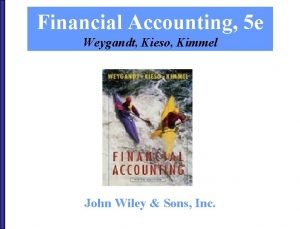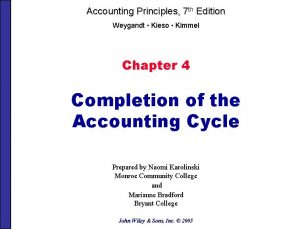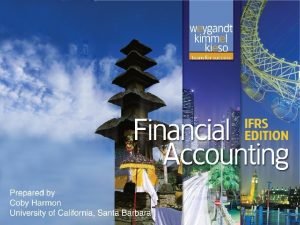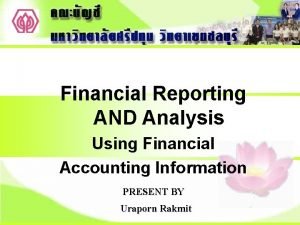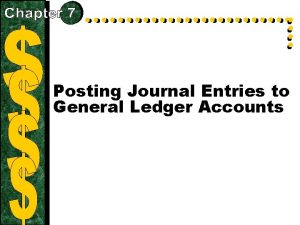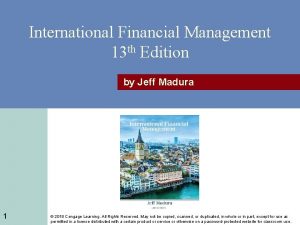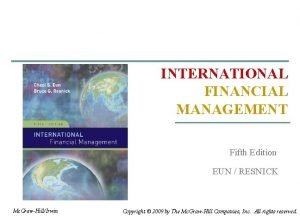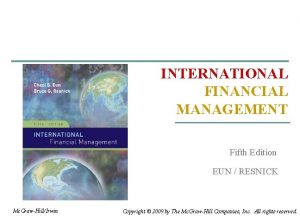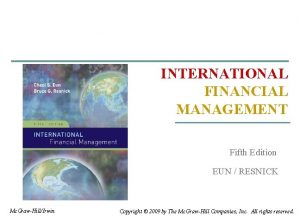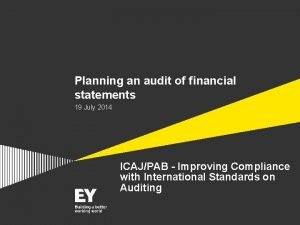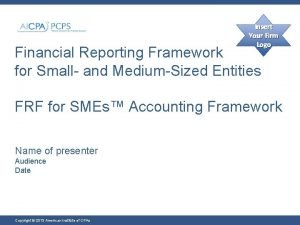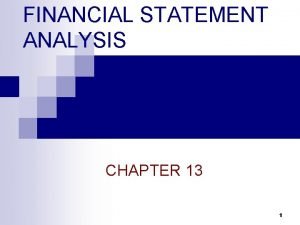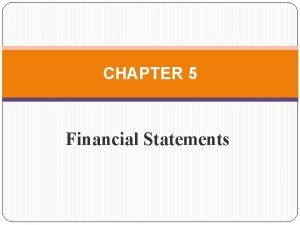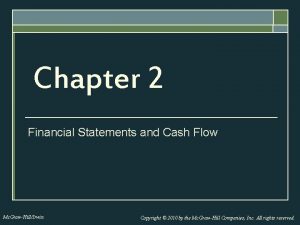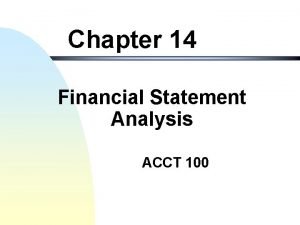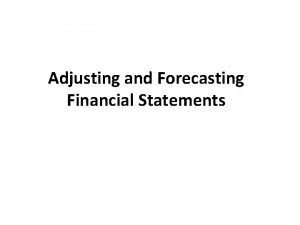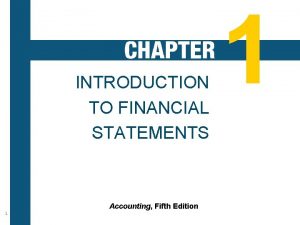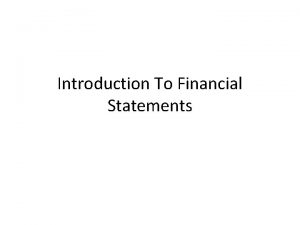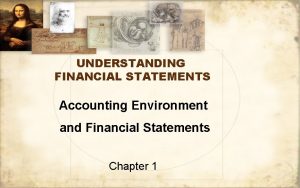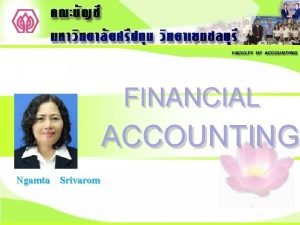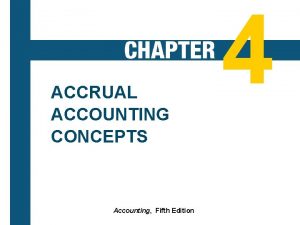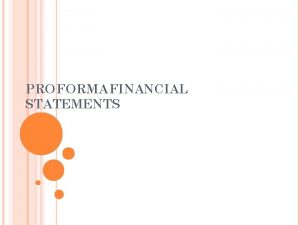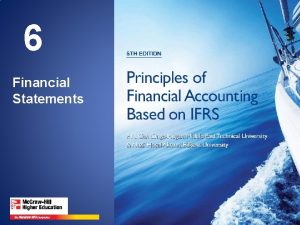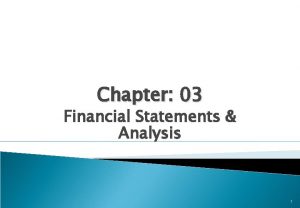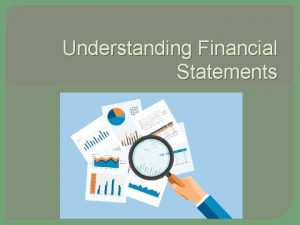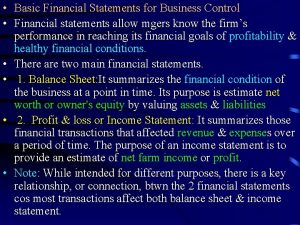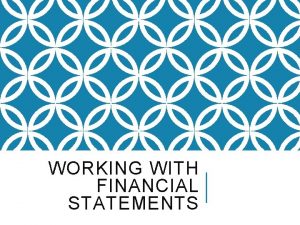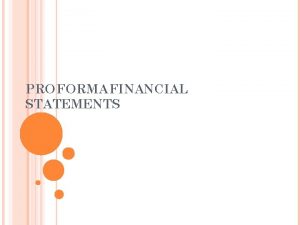INTRODUCTION TO FINANCIAL STATEMENTS 1 Accounting Fifth Edition
































- Slides: 32

INTRODUCTION TO FINANCIAL STATEMENTS 1 Accounting, Fifth Edition 1

Classify each item as an: a) asset b) liability c) common stock d) revenue e) expense. 1. Cost of renting property. 2. Truck purchased. 3. Notes payable. 4. Issuance of ownership shares. 5. Amount earned from providing service. 6. Amounts owed to suppliers. 2 LO 3 Explain the three principal types of business activity.

Learning Objectives After studying this chapter, you should be able to: 1. Describe the primary forms of business organization. 2. Identify the users and uses of accounting information. 3. Describe the content and purpose of each of the financial statements. 4. Explain the meaning of assets, liabilities, and stockholders’ equity, and state the basic accounting equation. 5. Describe the components that supplement the financial statements in an annual report. 6. Ethics in accounting. 3

Forms of Business Organization 4 LO 1 Describe the primary forms of business organization.

Users and Uses of Financial Information Internal Users Illustration 1 -1 Questions that internal users ask 5 2 LO

6

Users and Uses of Financial Information External Users Illustration 1 -2 Questions that external users ask 7 2 LO

Accounting Equation Assets = Assets Liabilities + Equity Liabilities & Equity 8

Assets – What you OWN Cash Accounts RECEIVABLE Prepaid Expenses Store Supplies Resources owned or controlled by a company Notes RECEIVABLE Land Buildings Equipment 9

Liabilities – What you OWE Accounts PAYABLE Notes PAYABLE Creditors’ claims on assets Taxes PAYABLE Wages PAYABLE 10

Shareholders’ Equity – Owners’ Claim to Assets *Investments by the shareholders • Increases Equity ** Decreases Equity • • *Amounts earned from the sale of products or services Sales Revenue Interest Income Rent Revenue • • **Amounts spent to generate revenues Salaries Exp Rent Exp Interest Exp Utilities Exp **Returns made to shareholders 11

Why Accounting is Important Accounting is a system that Identifies Records GAAP Relevant Reliable Comparable information that is Communicates to help users make better decisions. 12

WHAT IS GAAP? - Generally accepted accounting principles (GAAP) are accounting principles, standards and procedures that companies must follow when they compile their financial statements. - GAAP standards are set by the Financial Accounting Standards Board - Goal is to provide ‘uniformity’ in financial reporting to allow for comparability/consistnacy - GAAP vs IFRS - Does GAAP mean that financial statements cannot be distorted? Why or why not? 13

Communicating with Users Companies prepare four financial statements from the summarized accounting data: 1) Income Statement* (Revenues – Expenses = Net Income) 2) Retained Earnings Statement* (Income – Dividends) 3) Balance Sheet** (Assets, Liabilities & Equity) * Represents a period of time (i. e. Jan 1 –Dec 31) ** Represents a single point of time (i. e Dec 31) Statement of Cash Flows* (Cash) (Ch 12) 14 LO 4 Describe the content and purpose of each of the financial statements.

Income Statement Was I profitable? Illustration 1 -4 15 LO 4 Describe the content and purpose of each of the financial statements.

Accounting Equation & Fin’l Statements Illustration 3 -2 Expanded accounting equation Income Statement Was I profitable? LO 1 Analyze the effect of business transactions on the basic accounting equation.

Account Identification & Income Statement Practice Problem Ex 1 -8, p 31 Tips to solve: Label each account as one of the following: ①Assets – what is OWNED ②Liabilities – what is OWED Equity – ③ Common stock – investments by shareholders ④ Dividends – investment returns to shareholders ⑤ Revenue – amounts earned from the sale of product or services ⑥ Expense – amounts spent to generate revenue

Retained Earnings Statement u Statement shows amounts and causes of changes in retained earnings during the period. u Time period is the same as that covered by the income statement. u Users can evaluate dividend payment practices. Retained Earnings Statement Illustration 1 -5 Helpful Hint The heading of this statement identifies the company, the type of statement, and the time period covered by the statement. 18 LO 4 Describe the content and purpose of each of the financial statements.

Accounting Equation & Fin’l Statements Illustration 3 -2 Expanded accounting equation Stmt of Retained Earnings Net Income/Income Statement LO 1 Analyze the effect of business transactions on the basic accounting equation.

Communicating with Users 1) Income Statement Illustration 1 -4 2) Retained Earnings Statement Illustration 1 -5 Net income is needed to determine the ending balance in retained earnings. 20 LO 4 Describe the content and purpose of each of the financial statements.

Balance Sheet – Financially Healthy? Balance Sheet u Reports assets and claims to assets at a specific point in time. u Assets = Liabilities + Stockholders’ Equity. u Lists assets first, followed by liabilities and stockholders’ equity. Illustration 1 -7 Helpful Hint The heading of a balance sheet must identify the company, the statement, and the date. LO 5 Explain the meaning of assets, liabilities, and stockholders’ 21 equity, and state the basic accounting equation.

Accounting Equation & Fin’l Stmts Balance Sheet – Financially Healthy? Illustration 3 -2 Expanded accounting equation Stmt of Retained Earnings Net Income/Income Statement LO 1 Analyze the effect of business transactions on the basic accounting equation.

Communicating with Users Retained Earnings Statement Balance Sheet Ending balance in retained earnings is needed in preparing the balance sheet. 23 LO 4 Describe the content and purpose of each of the financial statements.

Retained Earnings & Balance Sheet Practice Problem Ex 1 -10, p 32 Tips to solve: 1) Mark each account listed as an asset, liability, common stock, revenue or expense. 2) After identifying each account, indicate whether that account belongs on the Income Statement, Retained Earnings Statement or Balance Sheet. 3) Complete the Retained Earnings Statement and Balance Sheet according to the examples provided.

Elements of an Annual Report U. S. companies that are publicly traded must provide shareholders with an annual report. The annual report always includes: u Financial statements. u Management discussion and analysis. u Notes to the financial statements. u Auditor's report. LO 6 Describe the components that supplement the 25 financial statements in an annual report.

Other Elements of an Annual Report Management Discussion and Analysis Management discussion and analysis (MD&A) covers the company’s ability to pay near-term obligations, its ability to fund operations and expansion, and its results of operations. Management must highlight favorable or unfavorable trends and identify significant events and uncertainties that affect these three factors. LO 6 Describe the components that supplement the 26 financial statements in an annual report.

Other Elements of an Annual Report Notes to the Financial Statements u Clarify the financial statements. u Provide additional detail. Notes are essential to understanding a company’s operating performance and financial position. Illustration 1 -11 27 LO 6

Other Elements of an Annual Report Auditor’s opinion as to the fairness of the presentation of the financial position and results of operations and their conformance Illustration 1 -12 with generally accepted accounting principles. 28 LO 6

Users and Uses of Financial Information Ethics In Financial Reporting United States regulators and lawmakers were very concerned that the economy would suffer if investors lost confidence in corporate accounting because of unethical financial reporting. u Recent financial scandals include: Enron, World. Com, Health. South, AIG, and others. u Congress passed Sarbanes-Oxley Act of 2002. u Limits to consulting fees charged by audit firms u Management representation requirements u Effective financial reporting depends on sound ethical behavior. u Accounting has fundamental principles but involves judgment 29 LO 2 Identify the users and uses of accounting information.

Users and Uses of Financial Information Ethics In Financial Reporting Ethics Beliefs that distinguish right from wrong Accepted standards of good and bad behavior 30

Guidelines to Ethical Decisions ΠIdentify ethical concerns Use personal ethics to recognize ethical concern. Analyze options Consider all good and bad consequences. Make ethical decision Choose best option after weighing all consequences. 31

What is Ethics? https: //www. youtube. com/watch? v=v. Auv 0 Huj. Fbc 32
 Kimmel accounting 5th edition
Kimmel accounting 5th edition Kimmel financial accounting 7the edition
Kimmel financial accounting 7the edition Financial accounting ifrs 4th edition chapter 12
Financial accounting ifrs 4th edition chapter 12 Using financial accounting information 10th edition
Using financial accounting information 10th edition Unit 13 accounting and financial statements
Unit 13 accounting and financial statements Principles of marketing fifth european edition
Principles of marketing fifth european edition Psychology ciccarelli 5th edition
Psychology ciccarelli 5th edition Fundamentals of corporate finance fifth edition
Fundamentals of corporate finance fifth edition Democritus atomic model diagram
Democritus atomic model diagram Segregat
Segregat Molecular biology
Molecular biology Human anatomy fifth edition
Human anatomy fifth edition Human anatomy fifth edition
Human anatomy fifth edition Intermediate accounting chapter 1
Intermediate accounting chapter 1 Investment center ppt
Investment center ppt Importance of ledger
Importance of ledger Using mis (10th edition) 10th edition
Using mis (10th edition) 10th edition Using mis 10th edition
Using mis 10th edition International financial management jeff madura ppt
International financial management jeff madura ppt Expanded opportunity set international finance
Expanded opportunity set international finance Expanded opportunity set international finance
Expanded opportunity set international finance International financial management 13th edition
International financial management 13th edition International financial management 5th edition
International financial management 5th edition Purpose of financial reporting
Purpose of financial reporting Planning an audit of financial statements
Planning an audit of financial statements Sample notes to financial statements for small entities
Sample notes to financial statements for small entities Analysis of financial statements
Analysis of financial statements Foreign currency translation example
Foreign currency translation example Objectives of financial statements
Objectives of financial statements Chapter 03 financial analysis
Chapter 03 financial analysis Cash flow to creditors is equal to
Cash flow to creditors is equal to Acct 100
Acct 100 Forecasted financial statements
Forecasted financial statements
